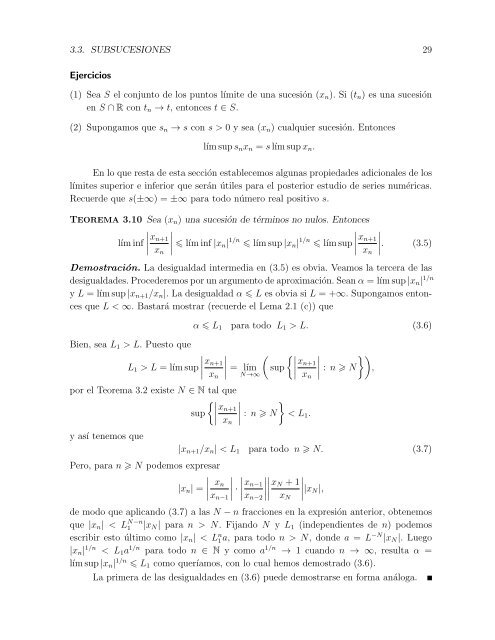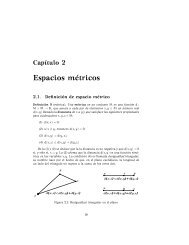Análisis Matemático vol. I Funciones de una variable real. *
Análisis Matemático vol. I Funciones de una variable real. *
Análisis Matemático vol. I Funciones de una variable real. *
Create successful ePaper yourself
Turn your PDF publications into a flip-book with our unique Google optimized e-Paper software.
3.3. SUBSUCESIONES 29<br />
Ejercicios<br />
(1) Sea S el conjunto <strong>de</strong> los puntos límite <strong>de</strong> <strong>una</strong> sucesión (xn). Si (tn) es <strong>una</strong> sucesión<br />
en S ∩ R con tn → t, entonces t ∈ S.<br />
(2) Supongamos que sn → s con s > 0 y sea (xn) cualquier sucesión. Entonces<br />
lím sup snxn = s lím sup xn.<br />
En lo que resta <strong>de</strong> esta sección establecemos alg<strong>una</strong>s propieda<strong>de</strong>s adicionales <strong>de</strong> los<br />
límites superior e inferior que serán útiles para el posterior estudio <strong>de</strong> series numéricas.<br />
Recuer<strong>de</strong> que s(±∞) = ±∞ para todo número <strong>real</strong> positivo s.<br />
TEOREMA 3.10 Sea (xn) <strong>una</strong> sucesión <strong>de</strong> términos no nulos. Entonces<br />
<br />
xn+1<br />
<br />
lím inf <br />
lím inf |xn| 1/n lím sup |xn| 1/n <br />
<br />
lím sup <br />
<br />
xn<br />
xn+1<br />
xn<br />
<br />
<br />
<br />
. (3.5)<br />
Demostración. La <strong>de</strong>sigualdad intermedia en (3.5) es obvia. Veamos la tercera <strong>de</strong> las<br />
<strong>de</strong>sigualda<strong>de</strong>s. Proce<strong>de</strong>remos por un argumento <strong>de</strong> aproximación. Sean α = lím sup |xn| 1/n<br />
y L = lím sup |xn+1/xn|. La <strong>de</strong>sigualdad α L es obvia si L = +∞. Supongamos entonces<br />
que L < ∞. Bastará mostrar (recuer<strong>de</strong> el Lema 2.1 (c)) que<br />
Bien, sea L1 > L. Puesto que<br />
<br />
<br />
L1 > L = lím sup <br />
<br />
α L1 para todo L1 > L. (3.6)<br />
xn+1<br />
xn<br />
por el Teorema 3.2 existe N ∈ N tal que<br />
<br />
xn+1 <br />
sup <br />
<br />
y así tenemos que<br />
Pero, para n N po<strong>de</strong>mos expresar<br />
<br />
<br />
|xn| = <br />
<br />
<br />
<br />
<br />
<br />
xn<br />
<br />
<br />
= lím sup<br />
N→∞<br />
xn+1<br />
xn<br />
<br />
: n N < L1.<br />
<br />
<br />
<br />
<br />
<br />
: n N ,<br />
|xn+1/xn| < L1 para todo n N. (3.7)<br />
xn<br />
xn−1<br />
<br />
<br />
<br />
·<br />
<br />
<br />
<br />
<br />
xn−1<br />
xn−2<br />
<br />
<br />
xN<br />
<br />
+ 1<br />
<br />
<br />
|xN|,<br />
<strong>de</strong> modo que aplicando (3.7) a las N − n fracciones en la expresión anterior, obtenemos<br />
que |xn| < L N−n<br />
1 |xN| para n > N. Fijando N y L1 (in<strong>de</strong>pendientes <strong>de</strong> n) po<strong>de</strong>mos<br />
escribir esto último como |xn| < Ln 1a, para todo n > N, don<strong>de</strong> a = L−N |xN|. Luego<br />
|xn| 1/n < L1a1/n para todo n ∈ N y como a1/n → 1 cuando n → ∞, resulta α =<br />
lím sup |xn| 1/n L1 como queríamos, con lo cual hemos <strong>de</strong>mostrado (3.6).<br />
La primera <strong>de</strong> las <strong>de</strong>sigualda<strong>de</strong>s en (3.6) pue<strong>de</strong> <strong>de</strong>mostrarse en forma análoga.<br />
xN




